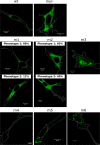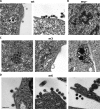Targeting of murine leukemia virus gag to the plasma membrane is mediated by PI(4,5)P2/PS and a polybasic region in the matrix
- PMID: 19828619
- PMCID: PMC2798412
- DOI: 10.1128/JVI.01134-09
Targeting of murine leukemia virus gag to the plasma membrane is mediated by PI(4,5)P2/PS and a polybasic region in the matrix
Abstract
Membrane targeting of the human immunodeficiency virus Gag proteins is dependent on phosphatidylinositol-(4,5)-bisphosphate [PI(4,5)P(2)] located in the plasma membrane. In order to determine if evolutionarily distant retroviral Gag proteins are targeted by a similar mechanism, we generated mutants of the matrix (MA) domain of murine leukemia virus (MuLV) Gag, examined their binding to membrane models in vitro, and analyzed their phenotypes in cell culture. In vitro, we showed that MA bound all the phosphatidylinositol phosphates with significant affinity but displayed a strong specificity for PI(4,5)P(2) only if enhanced by phosphatidylserine. Mutations in the polybasic region in MA dramatically reduced this affinity. In cells, virus production was strongly impaired by PI(4,5)P(2) depletion under conditions of 5ptaseIV overexpression, and mutations in the MA polybasic region altered Gag localization, membrane binding, and virion production. Our results suggest that the N-terminal polybasic cluster of MA is essential for Gag targeting to the plasma membrane. The binding of the MA domain to PI(4,5)P(2) appears to be a conserved feature among retroviruses despite the fact that the MuLV-MA domain is structurally different from that of human immunodeficiency virus types 1 and 2 and lacks a readily identifiable PI(4,5)P(2) binding cleft.
Figures







References
-
- Basyuk, E., T. Galli, M. Mougel, J. Blanchard, M. Sitbon, and E. Bertrand. 2003. Retroviral genomic RNAs are transported to the plasma membrane by endosomal vesicles. Dev. Cell 5:161-174. - PubMed
-
- Bradford, M. M. 1976. A rapid and sensitive method for the quantitation of microgram quantities of protein utilizing the principle of protein-dye binding. Anal. Biochem. 72:248-254. - PubMed
Publication types
MeSH terms
Substances
Grants and funding
LinkOut - more resources
Full Text Sources
Research Materials
Miscellaneous

